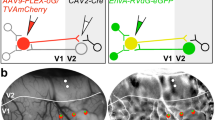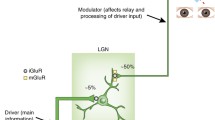Abstract
The function of lateral inhibitory synapses between striatal projection neurons is currently poorly understood. This paper puts forward a model suggesting that inhibitory collaterals can be used to enhance the incoming cortical signals. In particular, we propose that lateral inhibition between projection neurons performs a signal-enhancing process that resembles the image processing technique of “unsharp masking”, where a blurred copy is used to enhance and sharpen an input image. The paper also presents the results of computer simulations deomsntrating that the proposed mechanisms is compatible with known properties of striatal projection neurons, and outperforms alternative models of lateral inhibition. Finally, this paper illustrates the advantages of the proposed model and discusses the relevance of these conclusions for existing computational models of the basal ganglia and their role in cognition.









Similar content being viewed by others
References
Albin, R.L., Young, A.B., Penney, J.B. (1989). The functional anatomy of basal ganglia disorders. Trends in Neurosciences, 12, 366–375.
Alexander, G.E., DeLong, M.R., Strick, P.L. (1986). Parallel organization of functionally segregated circuits linking basal ganglia and cortex. Annual Review of Neuroscience, 9, 357–381.
Bar-Gad, I., Havazelet-Heimer, G., Goldberg, J.A., Ruppin, E., Bergman, H. (2000). Reinforcement-driven dimensionality reduction–a model for information processing in the basal ganglia. Journal of Basic and Clinical Physiology and Pharmacology, 11, 305–320.
Bogacz, R., & Gurney, K. (2007). The basal ganglia and cortex implement optimal decision making between alternative actions. Neural computation, 19(2), 442–477.
Fox, M.D., Snyder, A., Vincent, J., Corbetta, M., Essen, D.V., Raichle, M. (2005). The human brain is intrinsically organized into dynamic, anticorrelated functional networks. Proceedings of the National Academy of Sciences, 102, 9673–9678.
Frank, M.J., & Claus, E.D. (2006). Anatomy of a decision: striatoorbitofrontal interactions in reinforcement learning, decision making, and reversal. Psychological Review, 113(2), 300.
Frank, M.J., Loughry, B., O’Reilly, R.C. (2001). Interactions between frontal cortex and basal ganglia in working memory: a computational model. Cognitive, Affective & Behavioral Neuroscience, 1, 137–160.
Frank, M.J., Seeberger, L.C., O’Reilly, R.C. (2004). By carrot or by stick: cognitive reinforcement learning in parkinsonism. Science, 306(5703), 1940–1943.
Gurney, K., Prescott, T.J., Redgrave, P. (2001a). A computational model of action selection in the basal ganglia. i. a new functional anatomy. Biological Cybernetics, 84, 401–410.
Gurney, K., Prescott, T.J., Redgrave, P. (2001b). A computational model of action selection in the basal ganglia. ii. analysis and simulation of behaviour. Biological Cybernetics, 84, 411–423.
Haber, S.N. (2003). The primate basal ganglia: parallel and integrative networks. Journal of Chemical Neuroanatomy, 26(4), 317–330.
Humphries, M.D., Wood, R., Gurney, K. (2009). Dopamine-modulated dynamic cell assemblies generated by the gabaergic striatal micro-circuit. Neural Networks, 22(8), 1174–1188.
Humphries, M.D., Wood, R., Gurney, K. (2010). Reconstructing the three-dimensional gabaergic microcircuit of the striatum. PLoS Computational Biology, 6(11), e1001,011.
Izhikevich, E.M., & Edelman, G. (2008). Large-scale model of mammalian thalamocortical systems. Proceedings of the National Academy of Sciences, 105, 3593–3598.
Jaeger, D., Kita, H., Wilson, C.J. (1994). Surround inhibition among projection neurons is weak or nonexistent in the rat neostriatum. Journal of Neurophysiology, 72, 2555–2558.
Kemp, J.M., & Powell, T.P. (1970). The corticostriate projection in the monkey. Brain, 93, 525–546.
Levi, L. (1974). Unsharp masking and related image enhancement techniques. Computer Graphics and Image Processing, 3, 163–177.
Lippman, R.P. (1987). An introduction to computing with neural nets. IEEE Transaction on Acoustics, Speech, and Signal Processing, 35, 2–44.
McNab, F., & Klingberg, T. (2008). Prefrontal cortex and basal ganglia control access to working memory. Nature Neuroscience, 11, 103–107.
Moyer, J.T., Wolf, J.A., Finkel, L.H. (2007). Effects of dopaminergic modulation on the integrative properties of the ventral striatal medium spiny neuron. Journal of Neurophysiology, 98(6), 3731–3748.
Nisenbaum, E., & Berger, T. (1992). Functionally distinct subpopulations of striatal neurons are differentially regulated by gabaergic and dopaminergic inputs—I. In vivo analysis. Neuroscience, 48(3), 561–578.
O’Reilly, R.C., & Frank, M.J. (2006). Making working memory work: A computational model of learning in the prefrontal cortex and basal ganglia. Neural Computation, 18, 283–328.
O’Reilly, R.C., & Munakata, Y. (2000). Computational explorations in cognitive neuroscience. Cambridge: MIT Press.
Packard, M.G., & Knowlton, B.J. (2002). Learning and memory functions of the basal ganglia. Annual Review of Neuroscience, 25(1), 563–593.
Parent, A., & Hazrati, L.N. (1995a). Functional anatomy of the basal ganglia. i. the cortico-basal ganglia-thalamo-cortical loop. Brain Research Reviews, 20(1), 91–127.
Parent, A., & Hazrati, L.N. (1995b). Functional anatomy of the basal ganglia. ii. the place of subthalamic nucleus and external pallidium in basal ganglia circuitry. Brain Research Reviews, 20(1), 128–154.
Plenz, D. (2003). When inhibition goes incognito: feedback interaction between spiny projection neurons in striatal function. Trends in Neurosciences, 26(8), 436–443.
Pouget, A., Dayan, P., Zemel, R. (2000). Information processing with population codes. Nature Reviews Neuroscience, 1, 125–132.
Redgrave, P., Prescott, T.J., Gurney, K. (1999). The basal ganglia: A vertebrate solution to the selection problem. Neuroscience, 89, 1009–1023.
Schultz, W., Dayan, P., Montague, P.R. (1997). A neural substrate of prediction and reward. Science, 275(5306), 1593–1599
Stern, E.A., Jaeger, D., Wilson, C.J. (1998). Membrane potential synchrony of simultaneously recorded striatal spiny neurons in vivo. Nature, 394(6692), 475–478.
Stocco, A. (2012). Acetylcholine-based entropy in response selection: a model of how striatal interneurons modulate exploration, exploitation, and response variability in decision-making. Frontiers in Neuroscience, 6.
Stocco, A., & Anderson, J.R. (2008). Endogenous control and task representation: an fmri study in algebraic problem-solving. Journal of Cognitive Neuroscience, 20(7), 1300–1314.
Stocco, A., Lebiere, C., Anderson, J.R. (2010). Conditional routing of information to the cortex: A model of the basal ganglia’s role in cognitive coordination. Psychological Review, 117, 541–574.
Stocco, A., Lebiere, C., O’Reilly, R.C., Anderson, J.R. (2012). Distinct contributions of the caudate nucleus, rostral prefrontal cortex, and parietal cortex to the execution of instructed tasks. Cognitive, Affective, & Behavioral Neuroscience, 12(4), 611–628.
Tecuapetla, F., Carrillo-Reid, L., Guzmán, J.N., Galarraga, E., Bargas, J. (2005). Different inhibitory inputs onto neostriatal projection neurons as revealed by field stimulation. Journal of Neurophysiology, 93(2), 1119–1126.
Tepper, J.M., Koós, T., Wilson, C.J. (2004). Gabaergic microcircuits in the neostriatum. Trends in Neurosciences, 27(11), 662–669.
Tepper, J.M.,Wilson, C.J., Koós, T. (2008). Feedforward and feedback inhibition in neostriatal gabaergic spiny neurons. Brain Research Reviews, 58(2), 272–281.
Tunstall, M.J., Oorschot, D.E., Kean, A., Wickens, J.R. (2002). Inhibitory interactions between spiny projection neurons in the rat striatum. Journal of Neurophysiology, 88, 1263–1269.
Wickens, J., Kotter, R., Alexander, M. (1995). Effects of local connectivity on striatal function: Simulation and analysis of a model. Synapse, 20(4), 281–298.
Wilson, C.J. (2007). Gabaergic inhibition in the neostriatum. Progress in Brain Research, 160, 91–110.
Yelnik, J., Francois, C., Percheron, G., Tande, D. (1991). Morphological taxonomy of the neurons of the primate striatum. Journal of Comparative Neurology, 313, 273–294.
Yin, H.H., & Knowlton, B.J. (2006). The role of the basal ganglia in habit formation. Nature Reviews Neuroscience, 7(6), 464–476.
Zheng, T., & Wilson, C.J. (2002). Corticostriatal combinatorics: The implications of corticostriatal axonal arborizations. Journal of Neurophysiology, 87(2), 1007–1017.
Author information
Authors and Affiliations
Corresponding author
Additional information
Action Editor: Alessandro Treves
Conflict of interests
The authors declare that they have no conflict of interest.
Rights and permissions
About this article
Cite this article
Stocco, A., Lebiere, C. Inhibitory synapses between striatal projection neurons support efficient enhancement of cortical signals: A computational model. J Comput Neurosci 37, 65–80 (2014). https://doi.org/10.1007/s10827-013-0490-4
Received:
Revised:
Accepted:
Published:
Issue Date:
DOI: https://doi.org/10.1007/s10827-013-0490-4




